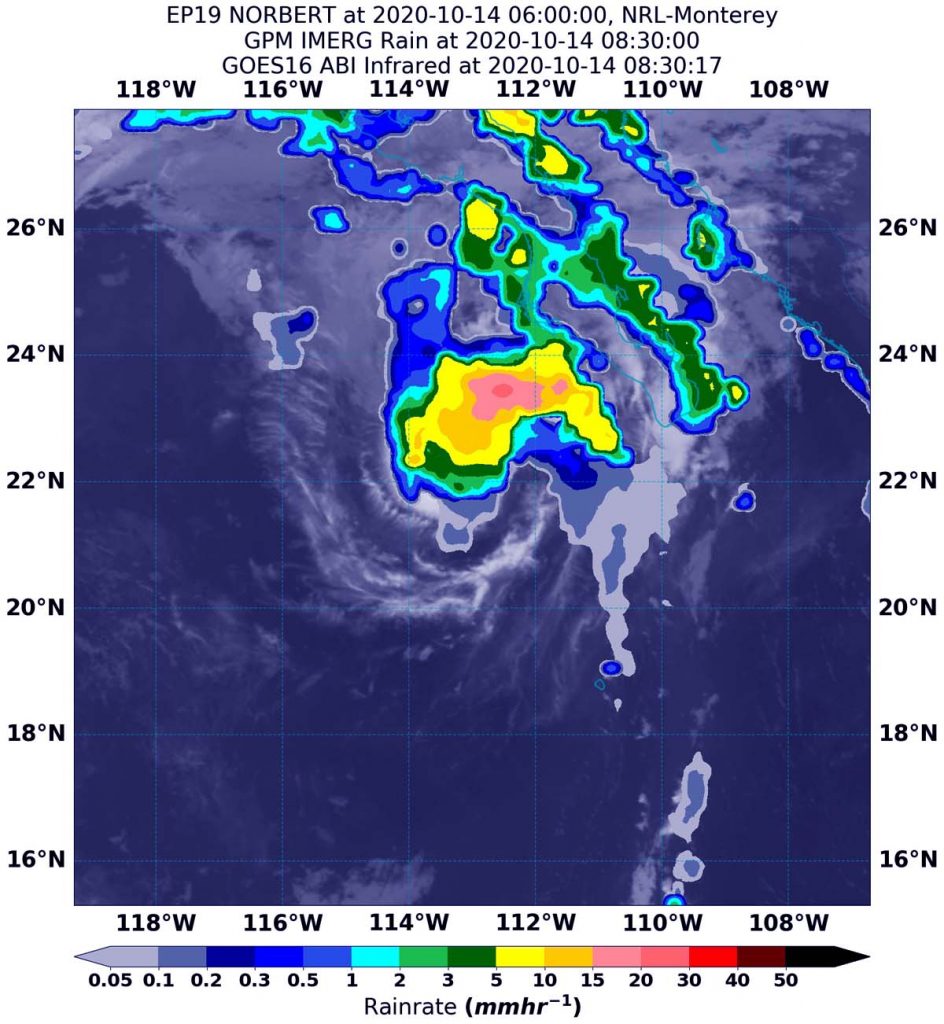Oct. 14, 2020 – NASA Rainfall Imagery Reveals Norbert Regains Tropical Storm Status
Norbert has been meandering around in the Eastern Pacific Ocean for several days as a tropical depression. A NASA satellite rainfall product that incorporates data from satellites and observations revealed that Norbert has regained tropical storm status after showing increased organization and deep convection.

Norbert’s Status on Oct. 14
At 5 a.m. EDT (0900 UTC), the center of Tropical Storm Norbert was located near latitude 22.1 degrees north and longitude 113.3 degrees west. Norbert is moving toward the northwest near 15 mph (24 kph). A northwestward motion with a gradual decrease in forward speed is expected through tonight. Maximum sustained winds remain near 40 mph (65 kph) with higher gusts. Little change in strength is expected this morning, but the tropical storm is forecast to begin weakening by later today. Norbert is forecast to become a remnant low tonight or early Thursday, and dissipate by Thursday night.
Estimating Norbert’s Rainfall Rates from Space
NASA’s Integrated Multi-satellitE Retrievals for GPM or IMERG, which is a NASA satellite rainfall product, estimated on Oct. 14 at 4:30 a.m. EDT (0830 UTC), Norbert was generating as much as 30 mm (1.18 inches) of rain per hour near the center of circulation. The National Hurricane Center noted that the exact location has been difficult to pinpoint in the area of deep convection.
Rainfall throughout most of the storm was estimated as falling at a rate between 5 and 15 mm (0.2 to 0.6 inches) per hour. At the U.S. Naval Laboratory in Washington, D.C., the IMERG rainfall data was overlaid on infrared imagery from NOAA’s GOES-16 satellite to provide a full extent of the storm.
What Does IMERG Do?
This near-real time rainfall estimate comes from the NASA’s IMERG, which combines observations from a fleet of satellites, in near-real time, to provide near-global estimates of precipitation every 30 minutes. By combining NASA precipitation estimates with other data sources, we can gain a greater understanding of major storms that affect our planet.
What the IMERG does is “morph” high-quality satellite observations along the direction of the steering winds to deliver information about rain at times and places where such satellite overflights did not occur. Information morphing is particularly important over the majority of the world’s surface that lacks ground-radar coverage. Basically, IMERG fills in the blanks between weather observation stations.
NASA Researches Tropical Cyclones
Hurricanes/tropical cyclones are the most powerful weather events on Earth. NASA’s expertise in space and scientific exploration contributes to essential services provided to the American people by other federal agencies, such as hurricane weather forecasting.
For more than five decades, NASA has used the vantage point of space to understand and explore our home planet, improve lives and safeguard our future. NASA brings together technology, science, and unique global Earth observations to provide societal benefits and strengthen our nation. Advancing knowledge of our home planet contributes directly to America’s leadership in space and scientific exploration.
For more information about NASA’s IMERG, visit: https://pmm.nasa.gov/gpm/imerg-global-image
For forecast updates on hurricanes, visit: www.hurricanes.gov
By Rob Gutro
NASA’s Goddard Space Flight Center
